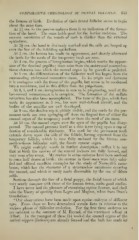Page 643 - My FlipBook
P. 643
COMPARATIVE CHRONOLOGY OF DENTAL FOLLICLE. 653
the foetuses at birth. Evokition of their dental follicles seems to begin
about the same time.
At 1-|- cm. in the porcine embryo there is no indication of the forma-
tion of the band. The same holds good for the bovine embryos. The
mucous membrane of the mouth of each is thicker than the external
epithelium.
At 2|- cm. the band is distinctly marked and the cells are heaped up
over the line of the infolding epithelium.
At 3 cm. the lamina has made its appearance, and shortly afterward
the buds for the cords of the temporary teeth are seen.
At 4 cm. the process of invagination begins, which marks the appear-
ance of the dentinal papillae; these arise from the embryonal connective-
tissue elements into which the enamel organ by its growth is projected.
At 5 cm. the differentiation of the follicular wall has begun from the
surrounding embryonal connective tissue. In its origin and character
it is analogous with the tissue of the papilla, but seems to be condensed
into a membrane, and in this differs from the pulp-tissue.
At 6, 7, and 8 cm. invagination is seen to be progressing, until at the
last-named measurement it is complete. The formation of the stellate
reticulum has also been accomplished. The bone of the jaw, which first
made its appearance at 3 cm., has now well-defined alveoli, and the
bodies of the maxilla? are vrell developed.
At 9 cm. the dentine cap is plainly visible, and the cords for the per-
manent teeth are seen springing off from the lingual face of either the
enamel organ of the temporary tooth or from the cord of the same.
At 10 cm. the enamel organ over the apex of the papilla has disap-
peared. The enamel presents itself as a thin layer lying upon a cap of
dentine of considerable thickness. The cord for the ])ermanent tooth
extends down upon the side of the follicle, having separated from the
temporary follicle, which is now fully enclosed by the fibrous con-
nective-tissue follicular wall, the future cement organ.
^ye might multiply words in further description ; suffice it to say
that at birth the crowns of the central incisors are fidly formed, and
very soon after erupt. My studies in ovine embryos have been confined
to some half dozen at birth ; the crowns in these cases were fully calci-
fied and offered excellent example^s for the study of Nasmyth's mem-
brane, which has the character of a structureless membrane covering
the enamel, and which is easily made discernible by the use of dilute
acids.
Sections through the face of a foetal puppy, the facial bones of which
very nearly com])are with those of the human foetus, make good studies.
I have never had the pleasure of examining equine foetuses, and fhall
take the liberty of quoting from Legro and Magitot, taken from Dean's
translation :
"Our observations have been made upon equine embryos of different
ages. From these we have determined certain facts in relation to the
various phases of follicular evolution. For the first three embryos we
are indebted to the courtesy of M. Raynal, of the veterinary school at
Alfort. In the youngest of these (14 weeks) the enamel organs of the
central nippers (incisors) are already formed and the bulb has made its


